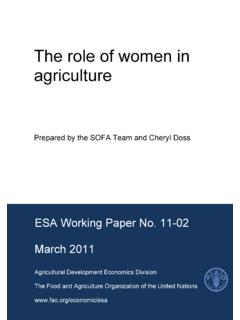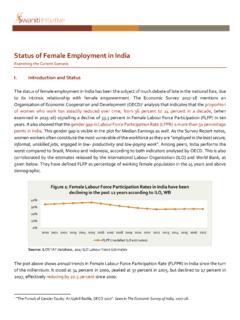Transcription of LABOUR FORCE IN SINGAPORE 2020 - Ministry of Manpower
1 |02| LABOUR FORCE in SINGAPORE 2020 LABOUR FORCE IN SINGAPORE 2020 (Impact of COVID-19 on the LABOUR Market) 1. Introduction In previous editions, the LABOUR FORCE in SINGAPORE report analysed longer-term structural trends of indicators, employment rate and income growth, which are not released in quarterly reports. These indicators are collected from the annual Comprehensive LABOUR FORCE Survey (CLFS) conducted in mid-year. However, as the conduct of CLFS 2020 coincided with the Circuit Breaker, the data will be largely influenced by this situation. Hence, the 2020 report focuses on analysing the impact of COVID-19 on different segments of the LABOUR FORCE , rather than longer-term 2. LABOUR FORCE Youth employment rate declined, while that for seniors continued to rise The employment rate for residents aged 15 & over declined from in 2019 to in 2020, the lowest since 2014. However, this was a smaller decrease than in past recessions, helped by slower population and LABOUR FORCE Youths aged 15 to 24 experienced the largest decrease in employment rate among all age groups, reflecting the employment contraction in sectors where they commonly worked such as Food & Beverage Services, Administrative & Support Services and Retail Trade.
2 While the employment rate for residents aged 25 to 64 also declined, it remained close to the average of in the past five years. The decrease was also smaller than in past recessions, as the employment rate for females held up ( ), given the underlying uptrend in their LABOUR FORCE participation rate. The employment rate for males moderated from to , the lowest level since 2004. The moderation for males was broad-based across finer age groups. In contrast, the employment rate for older residents aged 65 & over continued to increase, from in 2019 to in 2020, reflecting sustained efforts to raise their employability4 and higher demand for essential services like cleaning and security amid the COVID-19 outbreak. The employment rate for older residents also continued to increase in the last recession in 2009. 2 Data in this report are for June periods and pertain to residents (comprising SINGAPORE citizens and permanent residents) aged 15 & over, unless stated otherwise.
3 3 The resident population aged 15 & over grew by from June 2019 to June 2020. This is significantly lower than in past recessions, at in June 2009, in June 2003 and in June 1998. Source: SINGAPORE Department of Statistics 4 The bulk of the increase was from older workers continuing employment in their current job, as 89% of resident employees aged 65 to 69 had been in their current job for at least one year. LABOUR FORCE in SINGAPORE 2020 |03| Chart 1 Employment rate of residents aged 15 and over Per Cent Chart 2 Resident employment rate by age Per Cent Chart 3 Employment rate of residents aged 25 to 64 by sex Per Cent |04| LABOUR FORCE in SINGAPORE 2020 LABOUR FORCE participation rate held steady in 2020 Structural foundations in the LABOUR market remained firm, as the LABOUR FORCE participation rates of older residents and females aged 25 to 64 continued to rise in 2020. This balanced the larger than usual decrease in youth LABOUR FORCE participation rate ( over the year), as more youths stayed outside the LABOUR FORCE to pursue education.
4 As a result, the LABOUR FORCE participation rate for residents aged 15 & over in 2020 ( ) remained at around the level of 68% since 2015. Chart 4 LABOUR FORCE participation rate of residents aged 15 & over Per Cent female share of the LABOUR FORCE trended upwards over the decade, and held steady over the year Reflecting their uptrend in LABOUR FORCE participation, over the last decade the share of women in the resident LABOUR FORCE trended upwards from 44% in 2010 to 46% in 2020. Compared to a year ago, the share of women in the resident LABOUR FORCE and among the employed held steady at 46%, even though they were over-represented in industries more severely impacted by COVID-19 such as Wholesale Trade (47%), Retail Trade (57%), Accommodation (51%), Food & Beverage Services (57%) and Arts, Entertainment & Recreation (50%). Chart 5 Resident LABOUR FORCE by sex Number ( 000) LABOUR FORCE in SINGAPORE 2020 |05| Share of seniors in the LABOUR FORCE continued to rise With all post-war baby boomers reaching their mid-50s or beyond, and LABOUR FORCE participation rate of seniors continuing to rise despite the COVID-19 pandemic, the share of seniors in the resident LABOUR FORCE continued to rise.
5 26% of the resident LABOUR FORCE in 2020 were aged 55 & over, up from 17% in 2010. Prime working-age residents aged 25 to 54 remained the majority in the resident LABOUR FORCE , despite decreasing from 74% to 67% over the decade. Reflecting falling birth rates and with more youths staying outside the LABOUR FORCE to pursue education over the years, those aged 15 to 24 made up only a small group or of the resident LABOUR FORCE in 2020, down from in 2010. Chart 6 Resident LABOUR FORCE by age Per Cent Reflecting the above-average incidence of older workers in their workforce, Land Transport & Supporting Services ( taxi, private-hire car and bus drivers), Food & Beverage Services ( hawkers, food/drink stall assistants), Retail Trade ( shop sales assistants), Construction ( construction managers, supervisors/general foremen) and Cleaning & Landscaping ( cleaners) were among the industries with the highest number of senior workers aged 55 & over.
6 There were also industries with large number of senior workers because of their relatively large employment sizes overall, namely Wholesale Trade ( wholesale trade managers, clerks, shop sales assistants), Public Administration & Education ( clerks, private tutors, cleaners, teachers) and Health & Social Services ( cleaners, medical/dental receptionists, nurses). |06| LABOUR FORCE in SINGAPORE 2020 Chart 7 Top industries among employed residents aged 55 & over, June 2020 Number ( 000) More degree holders in the LABOUR FORCE With increased opportunities to pursue higher education over the years, the share of degree holders in the resident LABOUR FORCE continued to increase to 39% in 2020, up from 28% in 2010. Among those in employment, degree holders commonly worked in Public Administration & Education, Financial & Insurance Services, Professional Services, Wholesale Trade, Manufacturing, Information & Communications and Health & Social Services.
7 Chart 8 Resident LABOUR FORCE by highest qualification attained Per Cent LABOUR FORCE in SINGAPORE 2020 |07| As many of the sectors that degree holders commonly worked in were less impacted by the COVID-19 pandemic, the employment rate of degree holders aged 25 to 64 maintained at in 2020. However, degree holders in full-time employment experienced lower median income than a year ago. Degree holders were more likely to be in higher-income groups, where salaries tend to be more closely tied to bonuses and economic performance. Those in management positions may also have taken the lead in pay cuts, for companies more adversely affected by the pandemic. Despite the decrease in 2020, real median income growth for full-time employed degree holders in the recent five years (2015 to 2020) kept pace with the increase in the earlier five years (2010 to 2015). Chart 9 Employment rate of resident degree holders aged 25 to 64 Per Cent Chart 10 Median gross monthly income from work (including employer CPF contributions) of full-time employed resident degree holders Dollars |08| LABOUR FORCE in SINGAPORE 2020 The employment rate for young local polytechnic diploma holders aged 25 to 29 decreased over the year.
8 On the other hand, the employment rate for young degree holders from both the local autonomous universities and private education institutions held up well at around 90%. This was helped by the relatively high proportion of young degree holders who work in industries that were less affected by the COVID-19 outbreak, such as Information & Communications, Financial & Insurance Services and Professional Services. The median incomes for young local polytechnic diploma holders as well as degree holders in 2020 were lower than those in 2019, though they continued to be higher than the median income for the corresponding cohorts five years ago in 2015. Chart 11 Employment rate of residents aged 25 to 29 from local tertiary institutions Per Cent Chart 12 Median gross monthly income from work (including employer CPF contributions) of full-time employed residents aged 25 to 29 from local tertiary institutions Dollars LABOUR FORCE in SINGAPORE 2020 |09| The share of PMETs in the resident workforce rose faster, as industries with higher concentration of PMETs remain resilient The share of professionals, managers, executives & technicians (PMETs) among employed residents increased at a faster pace in 2020 than in earlier years, reaching 60%.
9 The number of residents in PMET jobs continued to rise steadily, as sectors with a high concentration of PMETs such as Information & Communications, Financial & Insurance Services and Professional Services were less impacted by the COVID-19 pandemic. On the other hand, the decline in non-PMET employment was larger than usual, pulled down by sectors more severely impacted by COVID-19 such as Wholesale Trade, Retail Trade, Accommodation and Food & Beverage Services. Most of these industries have a higher concentration of non-PMETs in their workforce. Chart 13 Employed residents by occupation Per Cent |10| LABOUR FORCE in SINGAPORE 2020 Steeper increase in time-related under-employment rate among non-PMETs, lower-educated and older workers The proportion of part-time workers among employed residents declined from in 2019 to in 2020, as services industries such as Food & Beverage Services ( waiters, food/drink stall assistants), Retail Trade ( shop sales assistants), Education ( private tutors, extracurriculum instructors) and Arts, Entertainment & Recreation ( physical fitness instructors) which typically employed more part-time workers were more impacted by COVID-19 and work stoppages, and cut back on part-time employment.
10 Chart 14 Share of part-time employed among employed residents Per Cent However, more part-timers were willing and available to work additional hours. The time-related under-employment rate5 increased from to over the year, but was below that during the Global Financial Crisis in 2009 ( ). Chart 15 Resident time-related under-employment rate Per Cent 5 Refers to part-timers who are willing and available to work additional hours as a percentage of all (full-time and part-time) employed residents. LABOUR FORCE in SINGAPORE 2020 |11| The time-related under-employment rate increased sharply in industries severely affected by COVID-19, including Retail Trade, Food & Beverage Services, Arts, Entertainment & Recreation, Construction and Transportation & Storage. As these were also sectors that employed more non-PMETs, and whose jobs were less suitable for remote work, non-PMETs experienced larger increases in time-related under-employment rate than PMETs.








